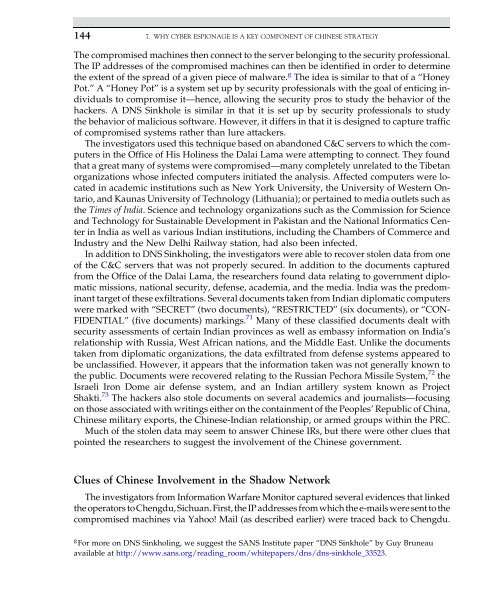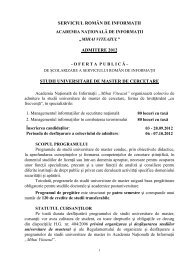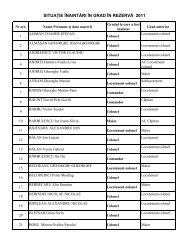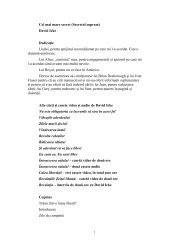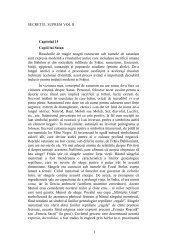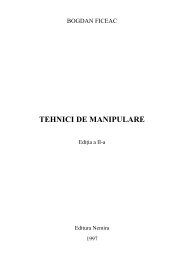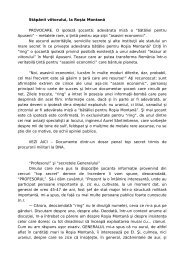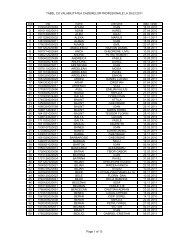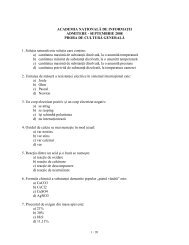Introduction to Cyber-Warfare - Proiect SEMPER FIDELIS
Introduction to Cyber-Warfare - Proiect SEMPER FIDELIS
Introduction to Cyber-Warfare - Proiect SEMPER FIDELIS
Create successful ePaper yourself
Turn your PDF publications into a flip-book with our unique Google optimized e-Paper software.
144 7. WHY CYBER ESPIONAGE IS A KEY COMPONENT OF CHINESE STRATEGYThe compromised machines then connect <strong>to</strong> the server belonging <strong>to</strong> the security professional.The IP addresses of the compromised machines can then be identified in order <strong>to</strong> determinethe extent of the spread of a given piece of malware. g The idea is similar <strong>to</strong> that of a “HoneyPot.” A “Honey Pot” is a system set up by security professionals with the goal of enticing individuals<strong>to</strong> compromise it—hence, allowing the security pros <strong>to</strong> study the behavior of thehackers. A DNS Sinkhole is similar in that it is set up by security professionals <strong>to</strong> studythe behavior of malicious software. However, it differs in that it is designed <strong>to</strong> capture trafficof compromised systems rather than lure attackers.The investiga<strong>to</strong>rs used this technique based on abandoned C&C servers <strong>to</strong> which the computersin the Office of His Holiness the Dalai Lama were attempting <strong>to</strong> connect. They foundthat a great many of systems were compromised—many completely unrelated <strong>to</strong> the Tibetanorganizations whose infected computers initiated the analysis. Affected computers were locatedin academic institutions such as New York University, the University of Western Ontario,and Kaunas University of Technology (Lithuania); or pertained <strong>to</strong> media outlets such asthe Times of India. Science and technology organizations such as the Commission for Scienceand Technology for Sustainable Development in Pakistan and the National Informatics Centerin India as well as various Indian institutions, including the Chambers of Commerce andIndustry and the New Delhi Railway station, had also been infected.In addition <strong>to</strong> DNS Sinkholing, the investiga<strong>to</strong>rs were able <strong>to</strong> recover s<strong>to</strong>len data from oneof the C&C servers that was not properly secured. In addition <strong>to</strong> the documents capturedfrom the Office of the Dalai Lama, the researchers found data relating <strong>to</strong> government diplomaticmissions, national security, defense, academia, and the media. India was the predominanttarget of these exfiltrations. Several documents taken from Indian diplomatic computerswere marked with “SECRET” (two documents), “RESTRICTED” (six documents), or “CON-FIDENTIAL” (five documents) markings. 71 Many of these classified documents dealt withsecurity assessments of certain Indian provinces as well as embassy information on India’srelationship with Russia, West African nations, and the Middle East. Unlike the documentstaken from diplomatic organizations, the data exfiltrated from defense systems appeared <strong>to</strong>be unclassified. However, it appears that the information taken was not generally known <strong>to</strong>the public. Documents were recovered relating <strong>to</strong> the Russian Pechora Missile System, 72 theIsraeli Iron Dome air defense system, and an Indian artillery system known as ProjectShakti. 73 The hackers also s<strong>to</strong>le documents on several academics and journalists—focusingon those associated with writings either on the containment of the Peoples’ Republic of China,Chinese military exports, the Chinese-Indian relationship, or armed groups within the PRC.Much of the s<strong>to</strong>len data may seem <strong>to</strong> answer Chinese IRs, but there were other clues thatpointed the researchers <strong>to</strong> suggest the involvement of the Chinese government.Clues of Chinese Involvement in the Shadow NetworkThe investiga<strong>to</strong>rs from Information <strong>Warfare</strong> Moni<strong>to</strong>r captured several evidences that linkedthe opera<strong>to</strong>rs <strong>to</strong>Chengdu, Sichuan. First,the IP addressesfrom whichthe e-mails were sent <strong>to</strong> thecompromised machines via Yahoo! Mail (as described earlier) were traced back <strong>to</strong> Chengdu.g For more on DNS Sinkholing, we suggest the SANS Institute paper “DNS Sinkhole” by Guy Bruneauavailable at http://www.sans.org/reading_room/whitepapers/dns/dns-sinkhole_33523.


